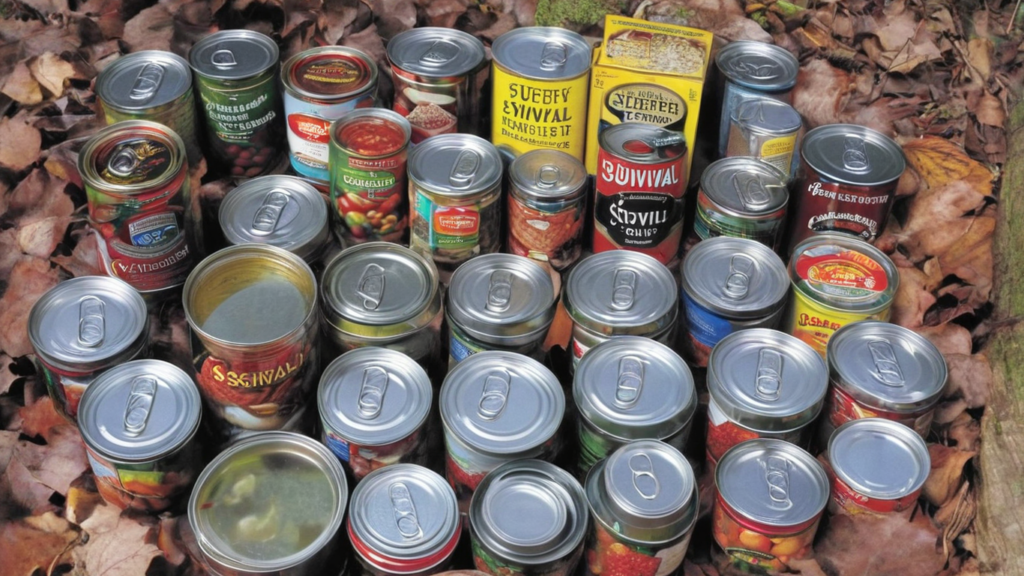How do you prepare dehydrated foods? – Unleashing the Power of Preservation

Dehydration, an age-old technique, is a fascinating and practical way to preserve and enjoy food. Imagine having your favorite fruits, vegetables, or even meats readily available, regardless of the season.
The process of dehydrating food is both an art and a science, involving the careful balance of temperature, humidity, and time. It’s a journey that requires patience, but the rewards are immensely satisfying.
In the realm of dehydrated foods, the possibilities are endless. From creating your own fruit leathers to making homemade jerky, the world of dehydrated foods is rich and diverse. This guide will take you through the intricacies of preparing dehydrated foods, from selecting the right ingredients to mastering the dehydration process.
So, are you ready to delve into this exciting world? Stay with us as we explore the art of preparing dehydrated foods, a journey that promises to be both educational and deliciously rewarding.
What is dehydrated food?
Dehydrated food is a product of a preservation process that involves removing the majority of water content from different types of food. This method not only extends the shelf-life of food but also reduces its weight, making it a convenient choice for outdoor activities such as camping or hiking.
The process of preparing dehydrated foods involves several steps. Initially, you need to select fresh and high-quality foods. This could be anything from fruits, vegetables, or even meats. The next step is washing and preparing the food. For instance, fruits and vegetables will need to be peeled and sliced into thin pieces. Meats, on the other hand, are generally cut into strips and pre-cooked.
Once prepared, the food is placed on the trays of a dehydrator, where it is exposed to low temperatures for an extended period. The duration of dehydration can vary depending on the type of food and the dehydrator model.
It’s important to note that the nutritional value of dehydrated foods remains mostly intact. Vitamins and minerals are preserved, providing a healthy, concentrated source of nutrition. However, the texture and taste can change significantly, which some people find appealing for their unique and intensified flavors.
The rehydration process is simple and typically involves soaking the food in water or cooking it in liquid. This allows the food to regain its original texture and volume, making it ready to be consumed.
Dehydrated food is a versatile and practical option for those looking for long-lasting, lightweight, and nutritious food options. By understanding the process, you can prepare and enjoy dehydrated foods in a variety of ways.
How is food dehydrated?
Food dehydration is a process that involves removing water from food to extend its shelf life and reduce weight for easy storage and transport. This is achieved through the application of heat at low temperatures over a prolonged period. The heat gently removes moisture while preserving the food’s nutrients and flavor.
The dehydration process typically involves three primary steps.
Firstly, the food is prepared. This involves cleaning, peeling, and slicing the food into thin, uniform pieces. This ensures even drying and prevents the growth of bacteria or mold.
Secondly, the food is arranged on the dehydration trays. The trays are then placed in the dehydrator, which circulates hot air to gradually remove moisture.
Lastly, the dehydrated food is stored in airtight containers to maintain its freshness and prevent the reabsorption of moisture.
It’s worth noting that different foods require different dehydration times and temperatures. For instance, fruits and vegetables are typically dehydrated at 130-140°F, while meats and fish are dehydrated at higher temperatures of 155-160°F.
Food dehydration is not only a practical way to preserve food, but it also offers a unique and tasty alternative to fresh food. Whether you’re planning a camping trip or simply looking for a healthy snack, dehydrated foods are a great option.
What foods can be dehydrated?
A wide variety of foods can be dehydrated to extend their shelf life and enhance their flavor. Fruits, such as apples, bananas, and berries, are popular choices for dehydration. The process intensifies their sweetness, making them a healthy alternative to processed snacks.
Vegetables like carrots, peppers, and tomatoes can also be dehydrated. After dehydration, they are often used in soups, stews, and sauces. However, it’s important to note that dehydrated vegetables may need to be rehydrated before use.
Meat is another food group that can be dehydrated. Jerky, a popular snack made from dehydrated meat, is a prime example. The dehydration process preserves the meat, allowing it to be stored for long periods.
Dehydration isn’t limited to these food groups. Herbs and spices can be dehydrated to create a concentrated flavor source. Even dairy products like milk and cheese can be dehydrated for long-term storage.
Lastly, some adventurous cooks even dehydrate cooked meals. This is especially popular among backpackers and campers who need lightweight, non-perishable food options. From pasta dishes to chili, almost any meal can be dehydrated with the right equipment and technique.
In conclusion, dehydration is a versatile method of food preservation that can be applied to a wide range of food types. Whether you’re a hiker needing lightweight meals or a home cook looking to extend the life of your produce, dehydration is a technique worth exploring.
Does dehydrating food kill bacteria?
Dehydrating food is a popular method of preservation that extends the shelf life of various food items. The process involves removing water from the food, which inhibits the growth of bacteria, yeast, and mold. However, does it kill bacteria?
The short answer is, not completely. While dehydrating food can significantly reduce the number of bacteria, it does not entirely eliminate them. Bacteria are remarkably resilient and can survive in extremely harsh conditions. They become dormant when dehydrated but can become active again when rehydrated.
Dehydrating food at a temperature of 140°F (60°C) or higher can kill most bacteria. However, lower temperatures may not be as effective. It’s essential to use a food dehydrator that can maintain a consistent high temperature for this reason.
• Proper preparation of the food before dehydrating can also help reduce bacteria. Washing fruits and vegetables thoroughly and cooking meat to the right temperature can kill bacteria before the dehydration process begins.
Remember, dehydrated foods should be stored in a cool, dry place to prevent bacteria growth. Also, rehydrating food with clean, safe water is crucial to avoid bacterial contamination.
In summary, while dehydrating food reduces the number of bacteria, it does not completely eliminate them. Therefore, proper food preparation and storage are vital in ensuring the safety of dehydrated foods.
How do you rehydrate dehydrated food?
Rehydrating dehydrated food is a simple process that involves the addition of water. This process brings the food back to a state similar to its original form before the dehydration process.
The first step is to place the dehydrated food in a container. The container should be clean and large enough to accommodate the food and the water.
Next, pour enough water to fully submerge the food. Warm water speeds up the rehydration process, but cold water can also be used, especially for fruits and vegetables.
After adding the water, cover the container and let the food soak. The soaking time varies depending on the type of food. For instance, dehydrated vegetables may take 1-2 hours, while beans may need up to 4 hours.
During the soaking process, it’s important to check the food periodically. This ensures it’s not becoming too soft or mushy.
Once the food has reached the desired texture, it can be drained and used in your recipe.
Remember, rehydrating dehydrated food is not an exact science. It’s more about personal preference and the specific requirements of your recipe. For best results, always follow the instructions provided with your dehydrated food.
Rehydrating dehydrated food is a key step in preparing meals with these types of products. It’s a simple process that can greatly enhance the flavor and texture of your dishes.
What are the benefits of dehydrated food?
Dehydrated foods, a result of the simple process of removing water from food, have numerous benefits. First and foremost, dehydrated foods have an extended shelf life. This is because the dehydration process inhibits the growth of bacteria, yeast, and mold that can cause food to spoil.
Another significant benefit is the convenience offered by dehydrated foods. They are lightweight and compact, making them perfect for outdoor activities like camping and hiking. Moreover, dehydrated foods require no refrigeration, which is a boon for those without access to regular electricity.
Dehydrated foods also retain most of their nutritional value. The dehydration process primarily removes water, leaving behind vitamins and minerals. In some cases, the concentration of nutrients can even increase due to dehydration.
It’s also worth noting that dehydrated foods can be rehydrated relatively easily. Simply soaking them in water or cooking them in liquid can bring them back to a near-original state. This means you can enjoy your favorite fruits, vegetables, and meats anytime, anywhere.
Dehydrating food also reduces food waste. If you have fruits or vegetables that are about to spoil, you can dehydrate them for future use. This not only saves money but also contributes to environmental sustainability.
Lastly, dehydrated foods offer a unique and concentrated flavor. The dehydration process intensifies the taste of foods, making them a delicious addition to meals and snacks.
In essence, dehydrated foods bring together the trifecta of convenience, nutrition, and taste, making them a smart choice for modern, busy lifestyles.
How long does dehydrated food last?
Dehydrated food, a popular choice for long-term storage, can last for years if properly stored. The longevity of these foods is largely dependent on factors such as the method of dehydration, the type of food, and storage conditions.
When it comes to the method of dehydration, air drying, sun drying, and oven drying are common techniques. However, electric food dehydrators are often preferred for their ability to maintain consistent temperatures, reducing the risk of bacterial growth and extending the shelf life of dehydrated foods.
The type of food also plays a significant role. Fruits and vegetables, when dehydrated, can last anywhere from 6 months to a year. On the other hand, dehydrated meats, properly prepared and stored, can last several years.
Storage conditions are equally important. Dehydrated foods should be stored in a cool, dark, and dry place to preserve their quality and nutritional value. Using vacuum-sealed containers or mylar bags with oxygen absorbers can further extend the shelf life of these foods.
To summarize, dehydrated foods can last for a significant amount of time when properly prepared and stored. However, it’s essential to check for signs of spoilage, such as changes in color or smell, before consumption.
Can dehydrated food go bad?
Dehydrated food, a popular choice for campers, hikers, and survivalists due to its lightweight and compact nature, can indeed go bad over time. The longevity of dehydrated food largely depends on the storage method and conditions.
When properly stored in a cool, dark, and dry place, dehydrated foods can last for years. However, exposure to heat, light, or moisture can significantly shorten this shelf life. For instance, dehydrated fruits and vegetables can last up to a year when stored correctly, but their nutritional value may start to degrade after six months.
It’s important to note that even though dehydrated food is less likely to spoil than fresh food, it’s still susceptible to bacterial growth and mold if not stored properly. This is especially true for meat-based dehydrated foods which are more prone to spoilage than plant-based ones.
To ensure the longevity of your dehydrated food, consider vacuum-sealing it, as this method removes air from the packaging, reducing the risk of bacterial growth. Also, store your dehydrated food in a dark, cool place to prevent the degradation of vitamins and minerals.
Remember to always check your dehydrated food for signs of spoilage before consumption. Look for changes in color, smell, or texture. If the food appears moldy or has an off smell, it’s best to discard it.
While dehydrated food is a convenient option for long-term storage and outdoor adventures, proper food handling and storage practices are crucial to ensure its safety and longevity.
Conclusion: Embracing the Art of Dehydrating Foods
In summary, dehydrated foods are a versatile and practical addition to any pantry. The process involves removing water from food, which not only extends its shelf life but also preserves its nutritional content. A wide variety of foods can be dehydrated, offering endless possibilities for culinary creativity.
While dehydrating food does not kill all bacteria, it significantly reduces the amount present, making the food safer for consumption. When it’s time to consume, rehydrating dehydrated food is a straightforward process that restores its original texture and flavor.
The benefits of dehydrated food are manifold, including long shelf life, nutritional preservation, and convenience, especially for outdoor activities like camping or hiking. However, it’s crucial to store dehydrated food correctly to prevent it from going bad, even though it generally lasts longer than fresh food.
As we move forward, we can expect to see more innovations in food dehydration techniques, making it even more accessible and efficient. Embracing the art of dehydrating food can be a rewarding journey, providing a unique way to enjoy your favorite foods and expand your culinary repertoire. Don’t be afraid to experiment and discover the many benefits of this age-old preservation method.









